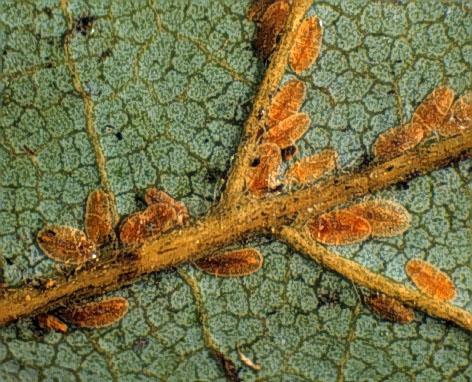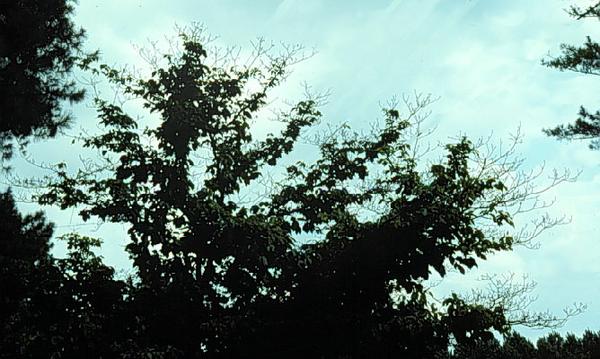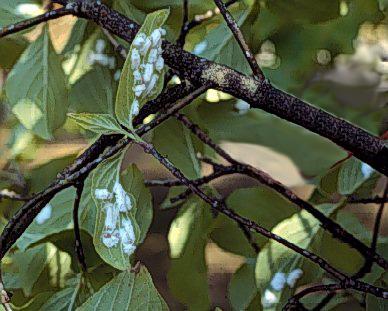General Information
Cottony maple leaf scale females, Pulvinaria innumerabilis, are 3 to 4mm long and 2 to 4mm wide. They are slightly convex and are brown with a yellow-brown ridge down the back (Figure 1). The body is covered with flakes of clear wax. Their eggs are white to pale yellow and are meshed in a white, cottony ovisac which may be up to 5mm wide and 12mm long. Newly hatched nymphs are pale yellow or green and translucent. They closely adhere to the undersides of leaves and are easily overlooked.
Biology
Cottony maple leaf scale is found throughout the eastern United States and southern Canada. It has also been reported from some western states. This scale feeds primarily on maple and dogwood in North Carolina, but it also infests hollies, Andromeda, and gum. Cottony scales suck sap from leaves (summer) and twigs (fall, winter, early spring) depriving the tree of valuable resources. They excrete honeydew in which can grow sooty mold. Consequently infested trees are stunted and appear scorched and black. Heavily infested trees have small flowers and leaves. Twig dieback may occur resulting in sparsely foliated canopy (Figure 2).
In April and May, cottony maple leaf scales move to the leaves and lay up to 2,500 eggs in cottony ovisacs on the undersides (Figure 3 and Figure 4). These egg-laying scales do not feed and they soon die. Crawlers hatch in late May to early June and feed on the underside of the host leaves, usually along the ribs of the leaf. In late summer, the scales crawl to the twigs where they feed for the rest of the fall, winter and early spring. In April, male scales develop into tiny, winged, gnatlike insects which mate with females and then die. After mating, the females crawl to the leaves to lay eggs. There is one generation each year.
Control
Several parasites and predators have been reported for the cottony maple leaf scale. The most abundant are in a group of small lady beetles in the genus Hyperaspis. These lady beetles and their larvae feed on the scale eggs in the ovisacs. Adult lady beetles are black with small orange spots. Immature lady beetles are gray but soon become covered with a thick, cottony covering of wax that makes them look like mealybugs. As the scale eggs hatch, the lady beetles leave, apparently to look for other prey. Thus by mid-June, the scale eggs have hatched, the crawlers are exposed on the undersides of leaves and the lady beetles are gone. This is the optimum time for control. The following pesticides are effective for control of cottony maple leaf scales.
Many systemic products are available that can be applied as foliar spray or drench. Drench applications should be made when eggs are present so the tree can take up the material by the time crawlers become active. Foliar applications should target crawlers. Contact insecticides such as pyrethroids may provide less consistent control because they rely on contacting the insect whereas systemics make the plant toxic for the insect to feed on. Therefore, systemic provide much longer control than contact insecticides and can kill all feeding stages. Horticultural oil can be used in winter when trees are without leaves to smother females living on branches. After leaves open thorough coverage is very difficult.
| Active Ingredient | Trade Name | Labeled Location | Activity | Signal Word | IRAC MOA Group | Compatible with Beneficials |
|---|---|---|---|---|---|---|
| acetamiprid | TriStar | G, N, L | Translaminar Systemic |
Caution | 4A | Yes |
| buprofezin | Talus | G, N | Contact | Caution | 16 | Yes |
| dinotefuran | Safari | G, N, L, I | Systemic | Caution | 4A | Yes |
| horticultural oil | many* | G, N, L, I | Contact | Warning | - | Yes |
| imidacloprid | Marathon II | G, N, I | Systemic | Caution | 4A | Yes |
| imidacloprid | Merit*, Bayer Advanced | G, N, L, I | Systemic | Caution | 4A | Yes |
| insecticidal soap | many* | G, N, L, I | Contact | Warning | - | Yes |
| pyriproxyfen | Distance | G, N, L | Translaminar | Caution | 7C | Yes |
| thiamethoxam | Flagship 25 WG | G, N | Translaminar | Caution | 4A | Yes |
| G = greenhouse, N = nursery, L = landscape, I = interiorscape * Suitable for homeowner use |
||||||
See the North Carolina Agricultural Chemicals Manual for additional insecticide choices.
Recommendations of specific chemicals are based upon information on the manufacturer's label and performance in a limited number of trials. Because environmental conditions and methods of application by growers may vary widely, performance of the chemical will not always conform to the safety and pest control standards indicated by experimental data.
Other Resources
- The Scale Insects of California: Part 1. The Soft Scales (Homoptera : Coccoidea : Coccidae). Gill, R. J. 1988. California Dept. of Food & Agriculture, Sacramento, CA. 132 pp.
- The soft scale insects of Florida (Homoptera: Coccoidea: Coccidae). Hamon, A. B. & Williams, M. L. 1984. Arthropods of Florida and Neighboring Land Areas. Fla. Dept. of Agric. & Consumer Serv. Div. Plant Ind., Gainesville. 194 pp.
- Soft Scale Identification and Management on Ornamental Plants. Frank, S. 2010. Entomology Insect Notes, NC State Extension Publications.
- NC State Extension Plant Pathology Publications and Factsheets
- NC State Horticultural Science Publications
- Plant Disease Notes
For assistance with a specific problem, contact your local N.C. Cooperative Extension center.
Publication date: Aug. 1, 2010
Reviewed/Revised: Sept. 18, 2019
Recommendations for the use of agricultural chemicals are included in this publication as a convenience to the reader. The use of brand names and any mention or listing of commercial products or services in this publication does not imply endorsement by NC State University or N.C. A&T State University nor discrimination against similar products or services not mentioned. Individuals who use agricultural chemicals are responsible for ensuring that the intended use complies with current regulations and conforms to the product label. Be sure to obtain current information about usage regulations and examine a current product label before applying any chemical. For assistance, contact your local N.C. Cooperative Extension county center.
N.C. Cooperative Extension prohibits discrimination and harassment regardless of age, color, disability, family and marital status, gender identity, national origin, political beliefs, race, religion, sex (including pregnancy), sexual orientation and veteran status.




